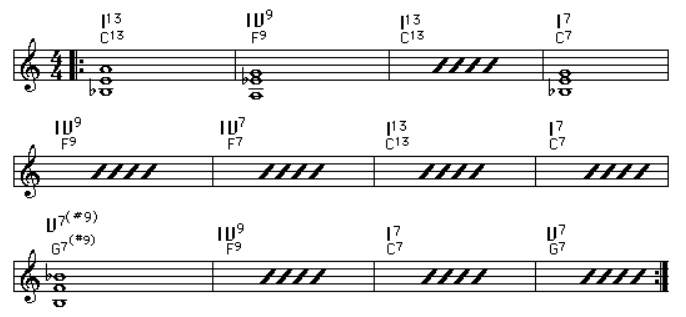A good place to start to learn the art of Jazz is with the
12 bar blues. This is what the mp3 audio file is playing, minus the
lead line.
A 12 bar blues is 12 bars (measures) that repeat over and over to allow each member in the band to improvise a new melody line during each 12 bar phrase. This is called a solo or soloing. Usually each soloist will solo on top of this 12 bar phrase over and over again until they feel they have exhausted their ideas for soloing.
A chord progression in Jazz is is often referred to as the changes. So, a 12 bar blues is a pattern of chords often referred to as the changes. Please refer to the image for this section to see the changes for the mp3 audio file you are playing.
There are NO RULES in Jazz. There are NO MISTAKES in Jazz. Jazz is a subjective art. If you like what you are playing, then play it. This is Jazz.
One thing to Keep in Mind
Jazz is like several painters working on the same painting at the same time. Imagine yourself in a group of painters about to begin an abstract painting of anger and loneliness, fear and hurt, joy and freedom, love and tenderness, or desire and frustration.
Each painter knows the canvas size. Each painter is going to add their version of the chosen topic without destroying or covering up what someone else is doing. Each painter knows that working together and supporting each other in this common effect will produce a painting that is understood by most people viewing the finished artwork. None of the painters in the group are in charge. The only restriction is the size of the canvas.
After thinking about this for a few minutes, listen to the music playing above and begin to experiment by adding some of your own notes to the music. Do this for as long as you would like to. Listen a little, play a little, listen a little, play a little, listen . . . and stop the mp3 player when you have finished.
Set aside some time each week (at least an hour) to sit uninterrupted and listen to a recording of a “small” Jazz group playing any kind of Jazz (Latin, Dixieland, Blues, Fusion, Swing, Scat, etc.). This will help you begin to build a library of ideas in your head and mind’s ear. These ideas will be seed thoughts to help you build new ideas of your own. At this point it is not necessary to know how any one player played a certain group of notes or rhythms. Just listen and enjoy. Let the music bathe and wash over you. Let it hold you and take you on a journey.


